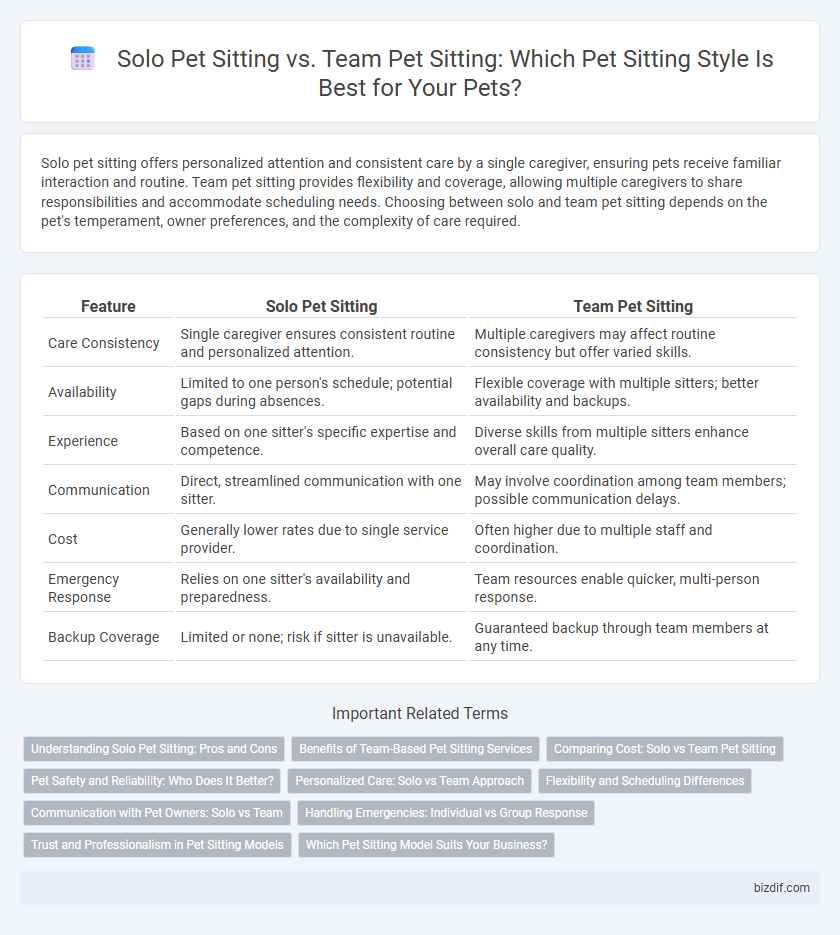Solo pet sitting offers personalized attention and consistent care by a single caregiver, ensuring pets receive familiar interaction and routine. Team pet sitting provides flexibility and coverage, allowing multiple caregivers to share responsibilities and accommodate scheduling needs. Choosing between solo and team pet sitting depends on the pet's temperament, owner preferences, and the complexity of care required.
Table of Comparison
| Feature | Solo Pet Sitting | Team Pet Sitting |
|---|---|---|
| Care Consistency | Single caregiver ensures consistent routine and personalized attention. | Multiple caregivers may affect routine consistency but offer varied skills. |
| Availability | Limited to one person's schedule; potential gaps during absences. | Flexible coverage with multiple sitters; better availability and backups. |
| Experience | Based on one sitter's specific expertise and competence. | Diverse skills from multiple sitters enhance overall care quality. |
| Communication | Direct, streamlined communication with one sitter. | May involve coordination among team members; possible communication delays. |
| Cost | Generally lower rates due to single service provider. | Often higher due to multiple staff and coordination. |
| Emergency Response | Relies on one sitter's availability and preparedness. | Team resources enable quicker, multi-person response. |
| Backup Coverage | Limited or none; risk if sitter is unavailable. | Guaranteed backup through team members at any time. |
Understanding Solo Pet Sitting: Pros and Cons
Solo pet sitting offers personalized attention and consistency, ensuring pets receive focused care tailored to their individual needs. However, it may limit availability during emergencies or multiple bookings, potentially causing scheduling challenges. Understanding these advantages and drawbacks helps pet owners choose the best care option for their pets' well-being.
Benefits of Team-Based Pet Sitting Services
Team-based pet sitting services provide continuous, reliable care by ensuring multiple caregivers share responsibilities, reducing the risk of scheduling conflicts or caregiver fatigue. This collaborative approach enhances pet well-being through diverse skill sets and personalized attention, offering coverage during emergencies or staff absences. Pet owners benefit from seamless communication and consistent updates, fostering trust and peace of mind.
Comparing Cost: Solo vs Team Pet Sitting
Solo pet sitting generally offers a more affordable rate due to fewer overhead costs and simpler scheduling, making it ideal for budget-conscious pet owners. Team pet sitting often comes at a higher price point but provides enhanced reliability and diverse expertise, which can justify the increased investment for pets with special needs. Comparing cost effectively depends on evaluating service complexity, pet requirements, and the frequency of visits to determine the best value between solo and team pet sitting options.
Pet Safety and Reliability: Who Does It Better?
Solo pet sitting ensures personalized attention with one dedicated caregiver, reducing communication errors and fostering a strong bond that enhances pet safety and reliability. Team pet sitting offers round-the-clock coverage and backup in emergencies, increasing reliability through shared responsibilities but may introduce inconsistencies due to multiple caregivers. Evaluating pet safety and reliability hinges on the pet's specific needs and the sitter's protocols, with solo sitters excelling in focused care and teams providing continuous support.
Personalized Care: Solo vs Team Approach
Solo pet sitting ensures highly personalized care by allowing focused attention on one pet's unique needs, behaviors, and routines, fostering strong bonds and consistent comfort. In contrast, a team pet sitting approach offers diverse expertise and shared responsibilities, which can benefit pets requiring specialized care or multi-pet households but may result in less individualized interaction. Both methods prioritize pet well-being, with solo sitting excelling in tailored companionship while teams provide comprehensive support through collaborative effort.
Flexibility and Scheduling Differences
Solo pet sitting offers personalized attention with flexible scheduling tailored to the pet's specific needs, often allowing last-minute changes and one-on-one care. Team pet sitting provides greater availability and coverage, accommodating multiple pets or longer time slots, but may involve coordinating schedules among several caregivers. Choosing between solo and team pet sitting depends on the balance between individual attention and scheduling convenience for pet owners.
Communication with Pet Owners: Solo vs Team
Solo pet sitting offers direct, consistent communication with pet owners, ensuring tailored updates and personalized attention to each pet's needs. Team pet sitting involves multiple caregivers, which can lead to varied communication styles and potential information gaps unless a centralized system is maintained. Effective communication platforms and clear protocols are essential in team settings to keep pet owners well-informed and confident in their pets' care.
Handling Emergencies: Individual vs Group Response
Solo pet sitting offers personalized attention, ensuring quick, focused responses during emergencies since one caregiver is solely responsible for the pet's well-being. Team pet sitting provides a collaborative approach, leveraging multiple caregivers to handle emergencies efficiently through shared expertise and immediate backup support. Both methods prioritize pet safety, but group response often allows faster intervention and resource access during critical situations.
Trust and Professionalism in Pet Sitting Models
Solo pet sitting offers personalized attention and builds strong trust through consistent one-on-one care, ensuring pets receive familiar and reliable interaction. Team pet sitting enhances professionalism by providing a network of trained caregivers, allowing for flexible scheduling and backup support during emergencies. Trust in team models grows from standardized protocols and collaborative communication, maintaining high care quality even when different sitters visit.
Which Pet Sitting Model Suits Your Business?
Solo pet sitting offers personalized care and strengthens client trust through consistent one-on-one interaction, ideal for small-scale businesses prioritizing bespoke service. Team pet sitting enables scalability and flexible scheduling by leveraging multiple caregivers, suitable for expanding operations or handling higher client volumes. Evaluating business goals, client needs, and resource availability helps determine whether solo or team pet sitting best suits your pet care venture.
Solo pet sitting vs Team pet sitting Infographic

 bizdif.com
bizdif.com